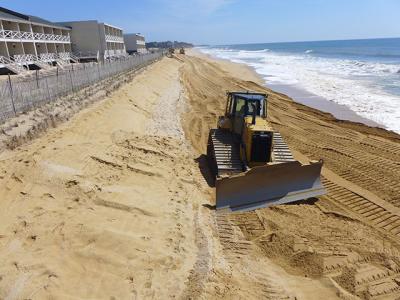Montauk Retreat Plan Taking Shape

As the East Hampton Town Board continues to work with consultants to craft a vision for future development in the town’s five hamlets, it took a hard look this week at opposite ends of the town, discussing a transfer of development rights program in downtown Montauk as a means of strategically retreating from the shoreline and a new approach for Wainscott’s commercial district.
Three months after presenting updated hamlet-study plans to the board, Peter Flinker of Dodson and Flinker, a Massachusetts consulting firm, and Lisa Liquori of Fine Arts and Sciences, a former town planning director, took the latest iteration of reports on the five hamlets, and a sixth study focusing on business, to the board’s meeting on Tuesday.
Public comment on a June 2017 presentation of draft reports was submitted through the end of last year. It is now up to the board to decide whether the draft reports are sufficient in their current form to be presented in a public hearing. Alternatively, said Ms. Liquori, the town could continue to solicit comment, make adjustments, and set priorities before scheduling a public hearing. The board could also combine those options in some fashion, she said.
The studies are to provide an understanding of the demographic trends and the dynamics that drive each unique hamlet’s economy, and present a master plan to implement a shared vision of more attractive, walkable, and economically viable villages, she said.
In Montauk, the consultants discussed a transfer of development rights program that would allow the downtown to remain where it is and at its present density, while also adapting to rising sea level by moving some businesses away from the shoreline.
This would require identification of a “receiving zone” that would absorb the businesses, such as the motels on South Emerson Avenue, the consultants said.
“We are really trying to save that whole area that would be prone to climate change,” said Councilwoman Sylvia Overby. “We can hardly keep sand on the beach now.” A transfer of development rights program is an opportunity she hoped businesses in Montauk would embrace “in order to keep Montauk as vital and alive as it is now.”
Such an approach “seems to make sense for Montauk,” Supervisor Peter Van Scoyoc said. The program would neither increase nor decrease density, important because tourism is the foundation of the hamlet’s economy, he said. “Having a strategy for adapting to sea level rise and erosion,” he said, “is something we should be working on but may not be accomplished in a 5 or 10-year timeline. . . . We need to plan ahead to ensure the future vitality of the business district. We need to have discussion now, to drill down to see how we can make this work over a long period of time so we don’t find ourselves trying to make decisions in the present tense.”
The process is yet to be determined, Mr. Van Scoyoc said, and will require further engagement with the public and discussion by the board and, perhaps, future consultants.
Implementing that project may require a new position in the town government, Councilman David Lys suggested. Ms. Liquori agreed. “It would be great if you adopted these as a vision and decided to go forward,” she said. “There is no one set way to go forward, but we put forward a lot of recommendations.”
Separately, in discussing the merits of applying overlay districts to regulate development specific to a hamlet, the board, Ms. Liquori, and Mr. Flinker held a long discussion about form-based code.
That, Mr. Flinker said, is “another name for a high-powered, design standard-driven code” that “focuses more on public space and the way buildings relate to that space.” It incorporates type of architecture, building facades, how buildings relate to the street, parking, and even standards for streets. “One of the innovations with the form-based code model is it’s based on a master plan” incorporating public streets, sidewalks, and buildings as one continuous design, he said. Put another way, it is a mechanism by which implementation of a plan is consistent even when happening incrementally, he said.
Such regulations use “physical form, rather than separation of uses, as the organizing principle for the code,” as defined by the Form-Based Codes Institute.
As an example, Mr. Flinker pointed to Wainscott’s commercial district, which is inconsistent and not always aesthetically pleasing, with parking in front of some structures and behind others. Form-based code would be a regulation and not merely a guideline, Mr. Flinker said, allowing certainty in development, “less time at the planning board arguing about the facade of this building and more on what you want as a town.” This would, of course, require consensus as to the overall character of future development.
The westernmost hamlet, said Mr. Van Scoyoc, is characteristic of “development done haphazardly and organically over time,” resulting in traffic problems. A service road behind the businesses would allow a more walkable downtown, like that of Amagansett, he said. “We can shape development and redevelopment to meet those needs, and have a result that is embraced by the community.”
If there is consensus, form-based code is a wise approach, Mr. Flinker said. The public design and planning sessions, or charettes, held early in the hamlet-study process, indicated a desire to create a more consistent look in downtown Wainscott, he said.
Parking could also be rethought as a single lot shared by businesses rather than the distinct lots separated by unused, empty strips, Mr. Flinker said. This would allow motorists to remain within the lot while driving to a different store, avoiding the need to re-enter Montauk Highway, he said, as well as better use of land and a reduction in the number of parking spaces needed.
While they were warm to the idea of form-based code, Mr. Van Scoyoc and Councilman Jeffrey Bragman worried that something akin to Disneyworld or, in the latter’s description, “faux-country strip mall,” could result.
